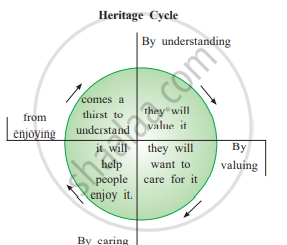Advertisements
Advertisements
प्रश्न
Pair up with your partner and answer the following question.
Where have you travelled?
उत्तर
It's a very personal answer - Students will have to write their own
APPEARS IN
संबंधित प्रश्न
Pair up with your partner and answer the following question.
Do you like to travel?
Heritage Sites - Rank these with your partner. Put the best at the top.
Great Barrier Reef
Mount Fuji
Grand Canyon
The Pyramids
Panda Sanctuaries
Machu Picchu
Vatican City
Great Wall of China
Your teacher will explain the ‘Heritage Cycle’.
By understanding (cultural heritage) people value it.
By valuing it people want to care for it.
By caring for it, it will help people enjoy it. From enjoying it, comes a thirst to understand. By understanding it____________

Why should we preserve the World Heritage Sites?
What is the role of World Heritage Sites in developing tourism in any country?
Complete the following.
| Year | Establishment | Role |
| 1954 | ____________ | ____________ |
| 1959 | ____________ | ____________ |
| 1965 | ____________ | ____________ |
| 1968 | ____________ | ___________ |
| 1972 | ____________ | ____________ |
Now each group representative from the previously formed groups, should narrate the information to the class, using proper attractive sentences.
Match the pairs to define different roles of the World Heritage Sites.
| A | B | ||
| 1 | Identify cultural and natural sites | a | green, local based, stable, and decent jobs |
| 2 | Identify sites of | b | of outstanding universal value across countries |
| 3. | Identify sites that represent | c | preserve outstanding sites and natural resources |
| 4. | UNESCO seeks to | d | tourism |
| 5. | World Heritage Sites should have | e | an asset for economic development and investment |
| 6 | World Heritage Sites should | f | protect these sites |
| 7. | World Heritage Sites serve as | g | best examples of world’s cultural and/or natural heritage |
| 8. | World Heritage Sites should ensure | h | special importance for everyone |
| 9 | It should at large develop | i | relevant development plan policies |
Do you know the difference between World heritage and Cultural heritage?
B1. Read the following passage and do the activities:
- International World Heritage Program is administered by ______.
- UNESCO
- WHO
- WHC
- UN
- World Heritage Sites are significant ______.
- Naturally and culturally
- Naturally and traditionally
- Naturally and literary
- None of these
- Which site played a role in historical Chinese art and literature?
- Aswan High Dam
- Mount Huangshan
- Abu Simbel Temple
- Egyptian artefacts
- UNESCO launched an international campaign in ______.
- 1950
- 1959
- 1958
- 1957
|
A World Heritage Site is a site determined by the United Nations Educational, Scientific and Cultural Organization (UNESCO) to have significant cultural or natural importance to humanity. As such, the sites are protected and maintained by the International World Heritage Programme which is administered by the UNESCO World Heritage Committee, because World Heritage Sites are places that are significant culturally and naturally, they vary in type but include forests, lakes, monuments, buildings and cities. World Heritage Sites can also be a combination of both cultural and natural areas. For example, Mount Huangshan in China is a site with significance to human culture because it played a role in historical Chinese art and literature. The mountain is also significant because of its physical landscape characteristics. HISTORY OF WORLD HERITAGE SITES Although the idea of protecting cultural and natural heritage sites around the world began in the early twentieth century, momentum for its actual creation was not started until the 1950s. In 1954, Egypt started plans to build the Aswan High Dam to collect and control water from the Nile River. The initial plan for the dam's construction would have flooded the valley containing the Abu Simbel Temples and scores of ancient Egyptian artefacts. To protect the temples and artefacts, UNESCO launched an international campaign in 1959 that called for the dismantling and movement of the temples to higher ground. The project cost an estimated US $80 million, $40 million of which came from 50 different countries. |
B2. Briefly describe the international campaign launched by UNESCO in 1959.
B3. Make sentences using the following phrases.
- Play a role
- Scores of
B4. Rewrite the following sentences using 'not only' and 'but also'.
- World Heritage Sites can also be a combination of both cultural and natural areas.
- Egypt started plans to build the Aswan High Dam to collect and control water from the Nile River.
B5. How do you think can an individual conserve and protect a World Heritage Site?
